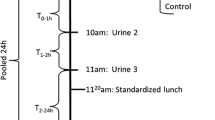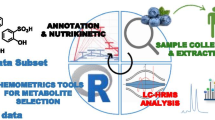Abstract
An untargeted metabolomics approach has been applied to discover and identify exposure markers in urine for nine Nordic meals. A cross-over meal study was carried out in 17 subjects. The meals included a Pie, a Soup and a Barleyotto (pearl barley based risotto), each prepared with three protein sources; meat, fish or vegetarian. Urine samples were collected in different time intervals before and after intake of the test meals, covering a total of 24 h. The samples were analyzed by UPLC-qTOF-MS. Discriminating features for meals and protein sources were selected by use of double cross-validated partial least squares discriminant analysis and two additional validation steps: (1) time-course of excretion and (2) analysis of sensitivity and specificity. In addition, eight meal studies with single foods were carried out to investigate the food sources of the markers. In total 31 potential exposure markers (PEMs) of foods were found for the meals and protein sources. Fifteen of the 31 PEMs were also found in studies with single foods. Ten PEMs were identified or putatively annotated. Among the PEMs were a range of conjugated isothiocyanates from the Brassica oleracea species. Trimethylamine N-oxide was found as a fish marker. Additional unknown PEMs were found for chicory salad, parsley and fava beans, while other PEMs were dependent on the meal matrix rather than individual foods. The study demonstrates that it is possible to find PEMs in 24 h urine samples even when foods are given as part of a complex meal.



Similar content being viewed by others
References
Agudo, A., Bailey, G. S., Bradlow, H. L., et al. (2004). Cruciferous vegetables, isothiocyanates and indoles. Lyon: International Agency for Research, on Cancer. IARC Press.
Barri, T., Holmer-Jensen, J., Hermansen, K., & Dragsted, L. O. (2012). Metabolic fingerprinting of high-fat plasma samples processed by centrifugation- and filtration-based protein precipitation delineates significant differences in metabolite information coverage. Analytica Chimica Acta, 718, 47–57.
Bijlsma, S., Bobeldijk, I., Verheij, E. R., et al. (2006). Large-scale human metabolomics studies: A strategy for data (pre-) processing and validation. Analytical Chemistry, 78, 567–574.
Bingham, S. A. (2002). Biomarkers in nutritional epidemiology. Public Health Nutrition, 5, 821–827.
Chong, I., & Jun, C. (2005). Performance of some variable selection methods when multicollinearity is present. Chemometrics and Intelligent Laboratory Systems, 78, 103–112.
Clarke, D. B. (2010). Glucosinolates, structures and analysis in food. Analytical Methods, 2, 310–325.
Favé, G., Beckmann, M. E., Draper, J. H., & Mathers, J. C. (2009). Measurement of dietary exposure: A challenging problem which may be overcome thanks to metabolomics? Genes and Nutrition, 4, 135–141.
Favé, G., Beckmann, M., Lloyd, A., et al. (2011). Development and validation of a standardized protocol to monitor human dietary exposure by metabolite fingerprinting of urine samples. Metabolomics, 7, 469–484.
Holmes, E., Loo, R. L., Stamler, J., et al. (2008). Human metabolic phenotype diversity and its association with diet and blood pressure. Nature, 453, 396–400.
Hwang, E. S., & Jeffery, E. H. (2003). Evaluation of urinary N-acetyl cysteinyl allyl isothiocyanate as a biomarker for intake and bioactivity of Brussels sprouts. Food and Chemical Toxicology, 41, 1817–1825.
Janobi, A. A. A., Mithen, R. F., Gasper, A. V., et al. (2006). Quantitative measurement of sulforaphane, iberin and their mercapturic acid pathway metabolites in human plasma and urine using liquid chromatography–tandem electrospray ionisation mass spectrometry. Journal of Chromatography B, 844, 223–234.
Jenab, M., Slimani, N., Bictash, M., et al. (2009). Biomarkers in nutritional epidemiology: Applications, needs and new horizons. Human Genetics, 125, 507–525.
Koulman, A., & Volmer, D. A. (2008). Perspectives for metabolomics in human nutrition: An overview. Nutrition Bulletin, 33, 324–330.
Liu, Z., & Franklin, M. R. (1984). Separation of four glucuronides in a single sample by high-pressure liquid chromatography and its use in the determination of UDP glucuronosyltransferase activity toward four aglycones. Analytical Biochemistry, 142, 340–346.
Llorach, R., Garrido, I., Monagas, M., et al. (2010). Metabolomics study of human urinary metabolome modifications after intake of almond (Prunus dulcis (Mill.) DA Webb) skin polyphenols. Journal of Proteome Research, 9, 5859–5867.
Lloyd, A. J., Fave, G., Beckmann, M., et al. (2011). Use of mass spectrometry fingerprinting to identify urinary metabolites after consumption of specific foods. American Journal of Clinical Nutrition, 94, 981–991.
Lodge, J. K. (2010). Symposium 2: Modern approaches to nutritional research challenges: Targeted and non-targeted approaches for metabolite profiling in nutritional research. Proceedings of the Nutrition Society, 69, 95–102.
Mithril, C., Dragsted, L. O., Meyer, C., Blauert, E., Holt, M. K., & Astrup, A. (2012a). Guidelines for the new Nordic diet. Public Health Nutrition, 15, 1941–1947.
Mithril, C, Dragsted, L. O., Meyer, C., Tetens, I., Jensen, A. B. & Astrup, A. (2012b). Dietary composition and nutrient content of the new Nordic diet, in press.
Nagata, C., Takatsuka, N., & Shimizu, H. (2002). Soy and fish oil intake and mortality in a Japanese community. American Journal of Epidemiology, 156, 824–831.
Nelson, A. C., Huang, W., & Moody, D. E. (2001). Variables in human liver microsome preparation: Impact on the kinetics of l-alpha-acetylmethadol (LAAM) n-demethylation and dextromethorphan O-demethylation. Drug Metabolism and Disposition, 29, 319–325.
O’Sullivan, A., Gibney, M. J., & Brennan, L. (2011). Dietary intake patterns are reflected in metabolomic profiles: Potential role in dietary assessment studies. American Journal of Clinical Nutrition, 93, 314–321.
Penn, L., Boeing, H., Boushey, C., et al. (2010). Assessment of dietary intake: NuGO symposium report. Genes and Nutrition, 5, 205–213.
Pluskal, T., Castillo, S., Villar-Briones, A., & Orešič, M. (2010). MZmine 2: Modular framework for processing, visualizing, and analyzing mass spectrometry-based molecular profile data. BMC Bioinformatics, 11, 395.
Puiggròs, F., Solà, R., Bladé, C., Salvadó, M., & Arola, L. (2011). Nutritional biomarkers and foodomic methodologies for qualitative and quantitative analysis of bioactive ingredients in dietary intervention studies. Journal of Chromatography A, 1218, 7399–7414.
Rouzaud, G., Young, S. A., & Duncan, A. J. (2004). Hydrolysis of glucosinolates to isothiocyanates after ingestion of raw or microwaved cabbage by human volunteers. Cancer Epidemiology, Biomarkers and Prevention, 13, 125–131.
Solanky, K. S., Bailey, N. J., Beckwith-Hall, B. M., et al. (2005). Biofluid 1H NMR-based metabonomic techniques in nutrition research: Metabolic effects of dietary isoflavones in humans. Journal of Nutritional Biochemistry, 16, 236–244.
Spencer, J. P. E., Abd El Mohsen, M. M., Minihane, A., et al. (2008). Biomarkers of the intake of dietary polyphenols: Strengths, limitations and application in nutrition research. British Journal of Nutrition, 99(1), 12–22.
Stella, C., Beckwith-hall, B., Cloarec, O., et al. (2006). Susceptibility of human metabolic phenotypes to dietary modulation. Journal of Proteome Research, 5, 2780–2788.
Sumner, L., Amberg, A., Barrett, D., Beale, M. H., et al. (2007). Proposed minimum reporting standards for chemical analysis. Metabolomics, 3, 211–221.
Svensson, B. G., Åkesson, B., Nilsson, A., & Paulsson, K. (1994). Urinary excretion of methylamines in men with varying intake of fish from the Baltic sea. Journal of Toxicology and Environment Health, 41, 411–420.
Vermeulen, M., Van Den Berg, R., Freidig, A. P., Van Bladeren, P. J., & Vaes, W. H. J. (2006). Association between consumption of cruciferous vegetables and condiments and excretion in urine of isothiocyanate mercapturic acids. Journal of Agriculture and Food Chemistry, 54, 5350–5358.
Walsh, M. C., Brennan, L., Pujos-Guillot, E., et al. (2007). Influence of acute phytochemical intake on human urinary metabolomic profiles. American Journal of Clinical Nutrition, 86, 1687–1693.
Wold, S., Johansson, E., & Cocchi, M. (1993). PLS—partial least-squares projections to latent structures. In H. Kubinyi (Ed.), 3D QSAR in drug design, theory, methods and applications (pp. 523–550). Leiden: ESCOM Leiden.
Xu, J., Yang, S., Cai, S., Dong, J., Li, X., & Chen, Z. (2010). Identification of biochemical changes in lactovegetarian urine using 1H NMR spectroscopy and pattern recognition. Analytical and Bioanalytical Chemistry, 396, 1451–1463.
Zhang, Y. (2004). Cancer-preventive isothiocyanates: Measurement of human exposure and mechanism of action. Mutation Research, 555, 173–190.
Zhang, A. Q., Mitchell, S. C., & Smith, R. L. (1999). Dietary precursors of trimethylamine in man: A pilot study. Food and Chemical Toxicology, 37, 515–520.
Zuppi, C., Messana, I., Forni, F., Ferrari, F. B., Rossi, C. B., & Giardina, B. (1998). Influence of feeding on metabolite excretion evidenced by urine 1H NMR spectral profiles: A comparison between subjects living in Rome and subjects living at arctic latitudes (Svaldbard). Clinica Chimica Acta, 278, 75–79.
Acknowledgments
The meal study was conducted as part of the OPUS project and is supported by a Grant from the Nordea Foundation. We would like to thank the study participants and the staff who have been involved in conducting the study, preparing the meals and analyzing the samples: Hanne Lysdal Petersen, Ümmühan Celik, Daniela Rago, Jan Stanstrup, the kitchen staff at the department and Meyers Madhus.
Author information
Authors and Affiliations
Corresponding author
Electronic supplementary material
Below is the link to the electronic supplementary material.
Rights and permissions
About this article
Cite this article
Andersen, MB.S., Reinbach, H.C., Rinnan, Å. et al. Discovery of exposure markers in urine for Brassica-containing meals served with different protein sources by UPLC-qTOF-MS untargeted metabolomics. Metabolomics 9, 984–997 (2013). https://doi.org/10.1007/s11306-013-0522-0
Received:
Accepted:
Published:
Issue Date:
DOI: https://doi.org/10.1007/s11306-013-0522-0




